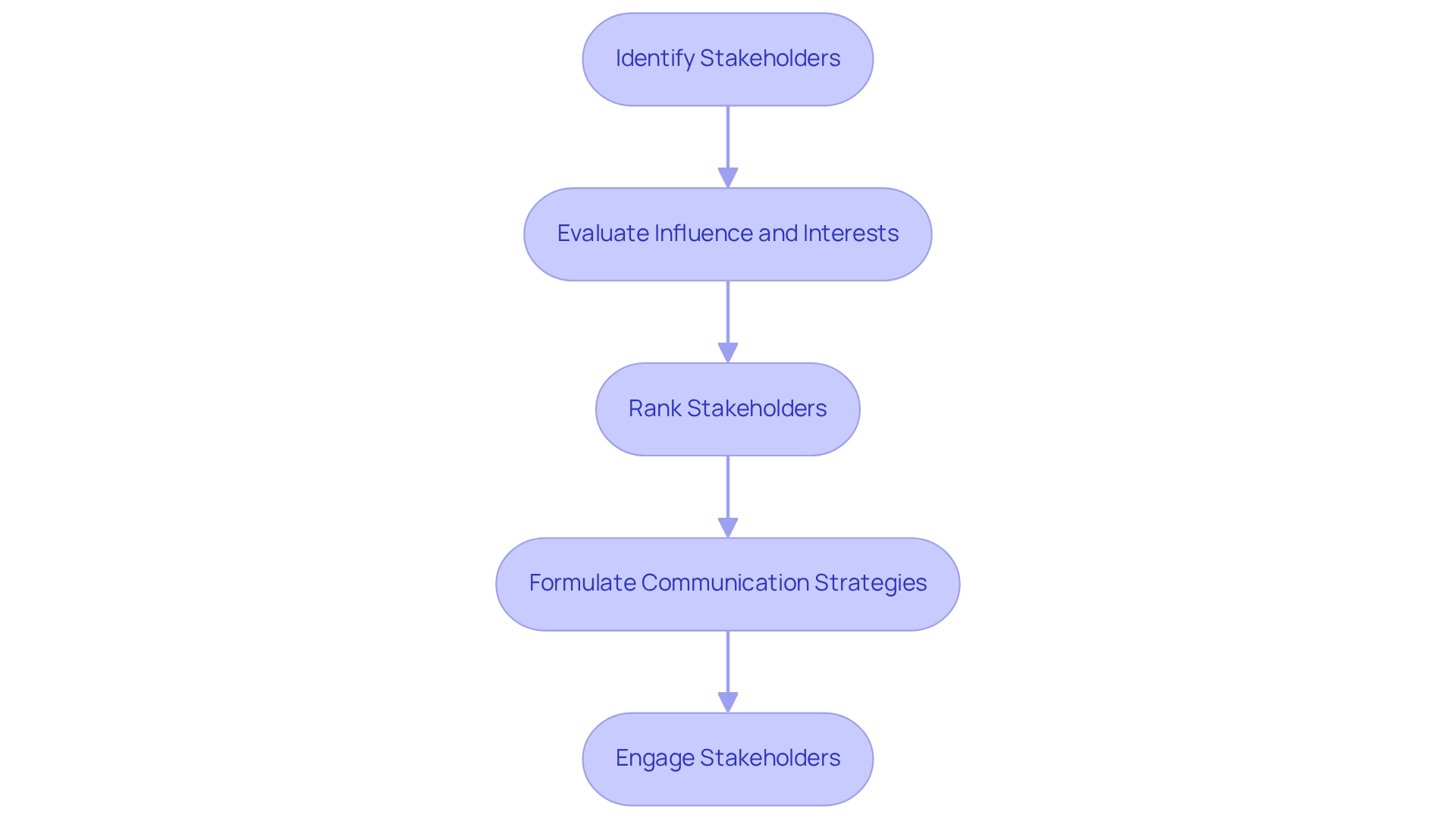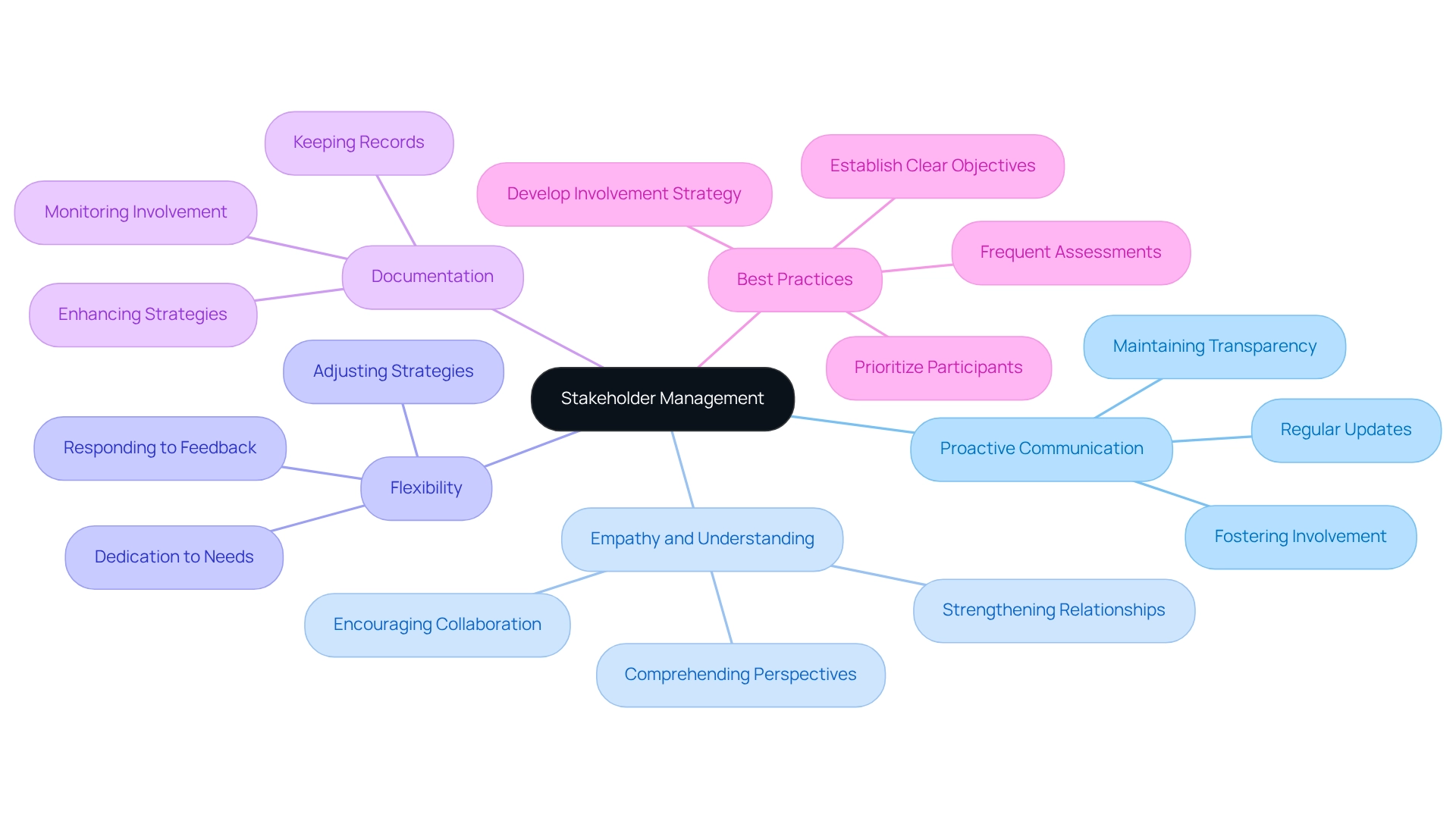Overview
The stakeholder management process is essential for project success. It involves systematically identifying, evaluating, involving, and addressing the needs of individuals or groups with a vested interest in a project. This systematic approach is crucial for ensuring alignment and garnering support. Effective stakeholder management not only enhances communication but also reduces misunderstandings and proactively mitigates risks. Consequently, this leads to improved project outcomes and organizational success. Embracing these practices is not just beneficial; it is imperative for any organization aiming for excellence.
Introduction
In an increasingly interconnected business landscape, the ability to effectively manage stakeholder relationships has never been more critical for project success. Stakeholder management encompasses a systematic approach to identifying, analyzing, and engaging with those who have a vested interest in a project, ensuring their needs and expectations are met.
As organizations strive to navigate the complexities of modern projects, the importance of aligning all parties with shared objectives becomes paramount. Moreover, statistics indicate that inadequate stakeholder involvement can lead to project failures, making the implementation of strategic engagement practices essential.
By prioritizing high-impact stakeholders and fostering open communication, businesses can enhance collaboration, mitigate risks, and ultimately drive better outcomes.
This article delves into the intricacies of stakeholder management, outlining its significance, essential processes, and best practices that can empower organizations to thrive in today's dynamic environment.
Define Stakeholder Management
What is stakeholder management process? It represents a systematic approach to recognizing, evaluating, involving, and addressing the needs and expectations of individuals or groups invested in an initiative. The question of what is stakeholder management process involves identifying participants' influence and interests, ranking them based on their potential impact on outcomes, and formulating tailored strategies for effective communication and collaboration throughout the lifecycle. Given that 33% of initiatives fail due to insufficient engagement from senior leadership, the efficient management of involved parties is essential for fostering alignment and support among all contributors.
In 2025, the emphasis on swift interaction is underscored by the fact that 39% of social media users expect prompt replies, highlighting the necessity for adaptable strategies across all participant groups. By concentrating efforts on key participants, organizations can ensure that their involvement initiatives are not only effective but also aligned with overarching project objectives. A comprehensive business assessment at the outset can aid in aligning critical participants and achieving a clearer understanding of the business context, thus facilitating the identification of fundamental issues and the development of strategic plans to leverage strengths.
Furthermore, evaluating hypotheses and maintaining a streamlined decision-making process are vital for promptly addressing the needs of interested parties and ensuring effective engagement. This systematic approach is particularly crucial for small to medium enterprises, where resource allocation for stakeholder interaction may be limited yet essential for crisis management and sustainable growth. Additionally, maintaining communication with external parties through methods such as email newsletters and monthly success stories can further enhance engagement initiatives, supported by real-time analytics to monitor performance and apply lessons learned.

Explain the Importance of Stakeholder Management
Understanding what is stakeholder management process? is paramount in aligning everyone with the initiative's goals, thereby ensuring their support and commitment. Efficient management enhances communication and reduces misunderstandings, which relates to what is stakeholder management process, fostering collaboration essential for achieving superior outcomes. By identifying potential risks early, proactive measures can be implemented to mitigate them, ultimately preserving project integrity.
In crisis situations, particularly during turnaround scenarios, it is essential to understand what is stakeholder management process? to manage the expectations of involved parties and maintain clear communication channels, as this can be the decisive factor between success and failure. Our commitment to employing a client dashboard for real-time business analytics allows teams to consistently track progress and take decisive action, thereby maintaining business integrity and enhancing trust among interested parties.
Entities that prioritize participant engagement frequently observe a significant reduction in risks associated with initiatives, leading to the inquiry of what is stakeholder management process, as demonstrated by case studies that illustrate improved organizational agility and responsiveness to participant needs. Furthermore, statistics indicate that establishing trust with involved parties can lead to a 10% increase in employee retention, which raises the question of what is stakeholder management process and its broader benefits.
In conclusion, understanding what is stakeholder management process? is essential, as the ability to engage interested parties effectively is not merely a best practice; it is a critical component of success.
Outline the Stakeholder Management Process Steps
The stakeholder management process encompasses several essential steps that are crucial for effective engagement and project success:
- Identify Stakeholders: Recognize all individuals or groups that may influence or be influenced by the initiative. This includes internal team members, external partners, customers, and regulatory bodies. Effective identification is essential, as companies that interact with interested parties can see a 20% rise in profits.
- Evaluate Participants: Examine each participant's degree of interest, influence, and possible effect on the initiative. This analysis assists in prioritizing participants based on their importance, which is crucial in understanding what is stakeholder management process, ensuring that resources are allocated effectively. Methods for participant analysis have demonstrated effectiveness in diverse business projects, improving decision-making processes. By utilizing real-time analytics, organizations can continuously observe the dynamics of their interests, enabling faster modifications to strategies as required.
- Involve Interested Parties: Create customized communication and involvement strategies for each group of interested individuals. This may involve regular updates, meetings, and feedback sessions to ensure their needs and concerns are addressed. As James Scott observes, handling conflicting interests can turn obstacles into chances, emphasizing the significance of proactive involvement. Additionally, Stephen R. Covey highlights that "the fundamental duty of leadership is to enhance the standard of living and the quality of life for all parties involved," emphasizing the leadership function in managing those affected. A dedication to implementing insights gained from prior interactions can nurture robust, enduring connections with partners.
- Monitor and Review: Continuously track participant engagement and satisfaction throughout the project. Adjust strategies as necessary to maintain positive relationships and address any emerging issues. This ongoing review process is vital, especially in a landscape where a significant percentage of social media users expect prompt responses, with studies indicating that 70% of users expect a response within an hour. Using a client dashboard for real-time business analytics can improve this monitoring process, ensuring that the needs of interested parties are addressed promptly and effectively.
The transition towards inclusive capitalism suggests that companies interacting effectively with their partners are 30% more likely to succeed with new products. This transition emphasizes the increasing significance of participant involvement in fostering innovation and success, especially pertinent for CFOs contemplating turnaround and restructuring consulting services.

Identify Key Characteristics and Best Practices
To understand what the stakeholder management process is, key characteristics of effective participant management include proactive communication, where regular updates on project progress and changes are essential for maintaining transparency and trust. This approach not only keeps interested parties informed but also fosters a sense of involvement, which can lead to improved employee retention—evidenced by a 10% increase in the technology sector when trust is built with these groups.
- Empathy and Understanding: Taking the time to comprehend the perspectives, needs, and concerns of these parties strengthens relationships and encourages collaboration. This compassionate method is essential in fostering a supportive atmosphere that boosts loyalty among involved parties.
- Flexibility: Adjusting strategies according to feedback from participants and changing situations is critical. This responsiveness shows a dedication to the needs of interested parties and can result in more successful outcomes.
- Documentation: Keeping thorough records of interactions, decisions, and feedback from interested parties is crucial for monitoring involvement and ensuring responsibility. This practice aids in enhancing strategies and boosting future interactions.
Best practices for managing involved parties consist of:
- Establishing clear objectives for involvement to align efforts with organizational goals.
- Prioritizing participants based on their influence and interest, ensuring that the most critical relationships receive appropriate attention. Significantly, 50% of a company's worth typically originates from merely 15-20 essential participant roles, emphasizing what the stakeholder management process is and the significance of proficient management. Developing a thorough participant involvement strategy that details communication methods and duties enables structured and productive interactions. Frequently assessing and modifying the involvement strategy based on participant input and project progress guarantees that the method stays pertinent and productive. As noted by the Harvard Business Review, concentrating on participants can enhance finances over time. By applying these traits and optimal methods, organizations can boost their involvement with interested parties, ultimately resulting in better financial outcomes and enduring expansion. For instance, a case study in the technology sector demonstrated that building trust with stakeholders resulted in a 10% improvement in employee retention, showcasing the tangible benefits of effective stakeholder engagement.

Conclusion
Effective stakeholder management transcends mere procedural necessity; it stands as a cornerstone for achieving project success within today’s intricate business landscape. By systematically identifying and analyzing stakeholders, organizations can craft engagement strategies that cater to the distinct needs and expectations of each participant. This proactive approach not only fosters open communication but also diminishes misunderstandings and encourages collaboration, ultimately resulting in enhanced project outcomes.
The importance of stakeholder management is highlighted by the potential repercussions of neglecting this critical domain. Statistics indicate that a significant proportion of projects falter due to insufficient stakeholder involvement, underscoring the imperative for strategic engagement practices. By prioritizing high-impact stakeholders and ensuring transparency, organizations can cultivate trust and mitigate risks—essential elements for navigating crises and preserving project integrity.
Integrating best practices such as proactive communication, empathy, and adaptability into stakeholder management processes can yield improved relationships and overall performance. By persistently monitoring and reviewing stakeholder engagement, organizations can adjust their strategies to accommodate evolving needs, reinforcing the significance of continuous dialogue and responsiveness.
Ultimately, effective stakeholder management serves as a vital element of project success that can propel innovation, enhance organizational agility, and contribute to sustainable growth. As businesses adopt this comprehensive approach, they position themselves not only to achieve immediate objectives but also to flourish in an interconnected and rapidly evolving environment.
Frequently Asked Questions
What is the stakeholder management process?
The stakeholder management process is a systematic approach to recognizing, evaluating, involving, and addressing the needs and expectations of individuals or groups invested in an initiative.
Why is stakeholder management important?
Efficient stakeholder management is essential for fostering alignment and support among all contributors, as 33% of initiatives fail due to insufficient engagement from senior leadership.
How are stakeholders identified and prioritized?
Stakeholders are identified based on their influence and interests, ranked according to their potential impact on outcomes, and tailored strategies for effective communication and collaboration are formulated.
What role does timely interaction play in stakeholder management?
Timely interaction is crucial, as 39% of social media users expect prompt replies, highlighting the need for adaptable strategies to engage all participant groups effectively.
How can organizations ensure effective stakeholder involvement?
By focusing efforts on key participants and conducting a comprehensive business assessment at the outset, organizations can align critical participants with project objectives and identify fundamental issues.
What is the importance of evaluating hypotheses in stakeholder management?
Evaluating hypotheses and maintaining a streamlined decision-making process are vital for promptly addressing the needs of interested parties and ensuring effective engagement.
How can small to medium enterprises manage stakeholder interactions effectively?
For small to medium enterprises, effective stakeholder interaction is essential for crisis management and sustainable growth, despite limited resource allocation.
What methods can enhance communication with external parties?
Maintaining communication through methods such as email newsletters and monthly success stories can enhance engagement initiatives, supported by real-time analytics to monitor performance and apply lessons learned.




